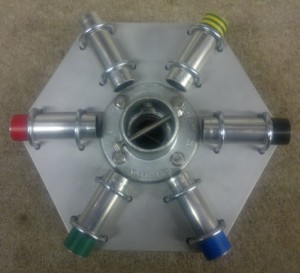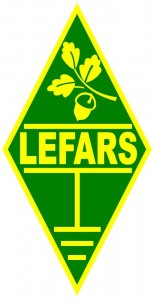The G3TXQ designed, MW0JZE manufactured, 20-6m Broadband Hexbeam.
A redesign of the Mike Traffie (Traffie Technology) HEXBEAM
Price £500
Website http://www.g3txq-hexbeam.com
What is it?
 Basically this is a number of boomless 2 element wire Yagis supported by fibreglass spreader arms in a hexagonal pattern. Each ‘Yagi’ consists of a full size driver and reflector. In fact, as supplied, each ‘Yagi’ is just one continuous piece, the wire driver and reflector separated by a short piece of cord.A picture speaks a thousand words, especially in my case! With one of these ‘Yagis’ for each band stacked one above another, you end up with an antenna that resembles a giant umbrella turned inside out by the wind and missing it’s cover.
Basically this is a number of boomless 2 element wire Yagis supported by fibreglass spreader arms in a hexagonal pattern. Each ‘Yagi’ consists of a full size driver and reflector. In fact, as supplied, each ‘Yagi’ is just one continuous piece, the wire driver and reflector separated by a short piece of cord.A picture speaks a thousand words, especially in my case! With one of these ‘Yagis’ for each band stacked one above another, you end up with an antenna that resembles a giant umbrella turned inside out by the wind and missing it’s cover.
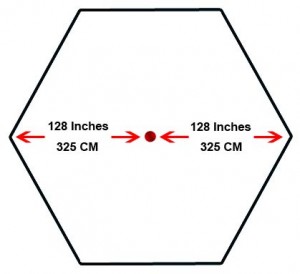 Dimensions:
Dimensions:
Point to Point of the hexagon, 21ft 6 inches. Height is around 4ft and weight around 25lbs
Performance:
On paper the performance doesn’t look anything special, but these are real figures, not marketing figures… and there’s a big difference between the two. G3TXQ has no financial interest in his design, and even Anthony MW0JZE basically builds them as a service more than a serious business venture. In fact both are keen to promote homebrew versions.
At 30ft in free space, forward gain for all bands is between 3.8dBd (20m) and 3dBd (on 12m). Front to back rejection is 22dBd at best on 20m, and down to 13dBd on 12m. SWR is close to flat across all bands, so you can traverse from one end of 20m to the other and never have to think about your ATU.
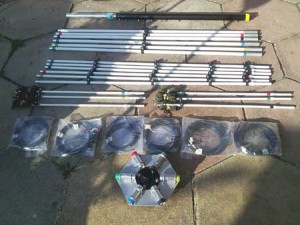 Assembly:
Assembly:
MW0JZE (Ant) has perfected the simplicity of construction of this antenna so that it can be assembled in under an hour by anyone.
He has uploaded videos to Youtube which show him assembling the antenna, although the supplied manual should be enough information for most people. Ant is a regular dxpeditioner, so ease of assembly whilst out in the field is of high importance to him. His Hexbeam was used extensively on the recent, and hugely successful, 4W6A dxpedition to East Timor, of which he was a team member.
It took me around an hour to construct this antenna, and all components fitted perfectly. Each of the 6 spreader arms consist of 3 sections which slide into each other and a screw secures them, although this is mainly to stop the sections rotating rather than stopping anything falling apart, as the supports cords at the tip of each element keep the whole antenna under tension. There is no need for a screw to secure each arm into the centre hub, tension is enough to hold them firm. In fact screws are not needed at all for temporary portable use.
Threading the elements through each of the d-loop/cleats on the spreader arms was the most time consuming aspect. My 6m band element was a bit saggy and could probably do with the cleats for that element being moved up the spreader arms slightly, but all elements should have a minor degree of sag and certainly shouldn’t be tight…. Just that they don’t look as eye-pleasing with an inch or two of sag. I tested the antenna at 8ft or so above the ground to make sure it was electrically sound and found the SWR was no higher than 2.5:1 across all bands, which would drop dramatically when raised to working height.
There’s no getting away from the fact that the Hexbeam is an awkward antenna when it comes to mounting it… it seems to want to snag on any piece of foliage in the vicinity. It’s not heavy and due to the balance, can be held up by one hand from the centre post but be aware of any local obstructions. I mounted my Hexbeam on a Clark Scam 12 pneumatic mast, with a 6ft aluminium tube into the top of the scam for the rotator to be fixed to, giving a working height of around 45ft, which puts the 20m element close to 50ft. Providing you remove the corresponding element on the hexbeam, there’s no reason why you cannot have a dedicated monoband yagi 4 or 5ft below the Hexbeam, 6 or 10m would be a logical choice.
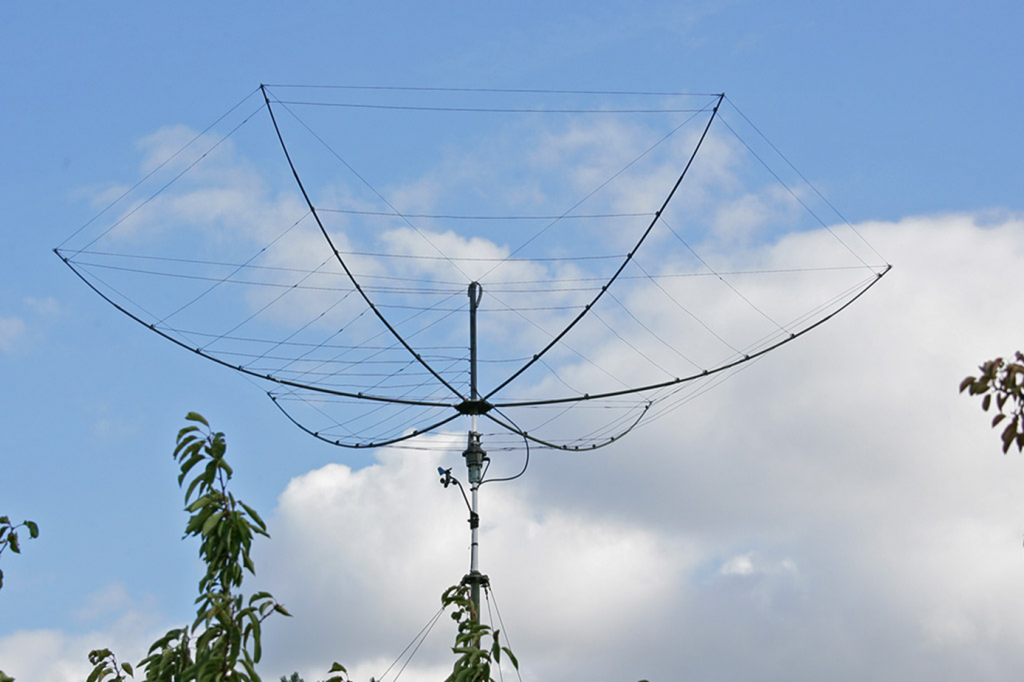
Why Did I chose the Hexbeam?
Over time, you get to know what other ‘G’ stations are using when they break the big pile-ups to the exotic dx, and the Hexbeam is consistently producing the goods for a large number of ‘G’ stations. OK, so the users of larger SteppIR and Optibeam antennas will generally get there first, but those using Hexbeams are neck and neck with many 3 element multiband trapped Yagis. The Hexbeam isn’t magical but seems to prove that 2 dedicated full size elements, albeit bent a little, are less of a performance compromise than some of the 3 element trapped multiband Yagi antennas on the market. It is certainly a leap up from the ubiquitous Cushcraft MA5B, which has a ‘wingspan’ not a great deal less than the Hexbeam.
In addition to U.K. dx’ers with hexbeams doing so well, I’m also hearing those using Hexbeams from all over the world putting out signals that are consistently up there with significantly larger antennas.
As previously mentioned, the wideband aspect is another factor, with minibeams often having less than 150Khz under an SWR of 3:1 on 20m, as well as other important performance factors such a F/B rejection and forward gain to covering only a small proportion of the larger bands.
In Use
Front to back rejection has been most impressive in early testing, with claimed figures looking about right when taking into account the modern trend of 3dB per S point of modern transceivers. The forward lobe of the Hexbeam is pretty wide and takes a bit of getting used to after the dipole type radiation pattern on my old TGM minibeam, which gave the impression of a far narrower front lobe, as it had all the rejection off the sides and next to none at the back. We’re only talking about 2 element beams, so narrow beamwidth is probably perception rather than reality.
Although I could not do A-B testing against my TGM minibeam, I could A-B test against my old G3TPW Cobwebb antenna (situated about 100ft away), which was used previously for A-B testing with the TGM. I lowered the Hexbeam to the same working height as the Cobwebb of 30ft. Not surprisingly the Hexbeam made mincemeat of the little Cobwebb, but it’s an unfair comparison and was not the point of the exercise. What it did prove, from memory of comparing TGM to Cobwebb, was that the received signal levels from longer haul dx (3,500 miles +) were far higher than that of the TGM, on all bands…most noticeable were 20m, 17m and 15m.
With propagation being so good of late, it’s it would be easy to reel off a string of exotic log entries but it would be rather meaningless. Suffice to say I have hit all the recent Pacific dxpeditions, which have always been a tough nut to crack (even T32C with 5w PEP). The good conditions on the bands apply to everyone, so getting in and breaking pile-ups, seemingly far quicker than before, maybe as valid a method of determining the antenna’s performance as anything else at my disposal.
Wet weather has no significant impact on this antenna, with SWR still comfortably below 2:1 across every band even during torrential rain. The antenna has no significant wind loading, although it really does want to twist, so watch out with cheap tv antenna type rotators. My Hexbeam has endured gusts reaching 38mph thus far without any problems, although if I saw significant winds forecast (50mph) I would lower the antenna, more to protect the mast than the actual antenna. Obviously there’s one question you won’t need to ask yourself with this HF beam during a gale… ‘where should I park it?’
73
Andy M0TTB (Email: m0ttb@lefars.org.uk)

